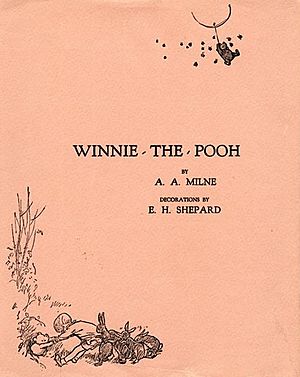Winnie-the-Pooh (book) facts for kids

First edition
|
|
| Author | A. A. Milne |
|---|---|
| Illustrator | E. H. Shepard |
| Country | United Kingdom |
| Genre | Short story collection, children's literature |
| Publisher | Methuen & Co. Ltd. (London) |
|
Publication date
|
14 October 1926 |
| Media type | Print (hardback & paperback) |
| Followed by | The House at Pooh Corner |
Winnie-the-Pooh (1926) is a best-selling classic children’s book. It is the first volume of stories about Winnie-the-Pooh, written by A. A. Milne and illustrated by E. H. Shepard. The book focuses on the adventures of a teddy bear called Winnie-the-Pooh and his friends Piglet, a small toy pig; Eeyore, a toy donkey; Owl, a live owl; and Rabbit, a live rabbit. The characters of Kanga, a toy kangaroo, and her son Roo are introduced later in the book, in the chapter entitled "In Which Kanga and Baby Roo Come to the Forest and Piglet has a Bath". The bouncy toy-tiger character of Tigger is not introduced until the sequel, The House at Pooh Corner.
In 2003, Winnie the Pooh was listed at number 7 on the BBC's survey The Big Read.
Contents
- In Which We Are Introduced to Winnie the Pooh and Some Bees and the Stories Begin
- Winnie-the-Pooh is out of honey, so he and Christopher Robin attempt to trick some bees out of theirs, with disastrous results.
- In Which Pooh Goes Visiting and Gets into a Tight Place
- Pooh visits Rabbit, but eats so much while in Rabbit's house that he gets stuck in Rabbit's door on the way out.
- In Which Pooh and Piglet Go Hunting and Nearly Catch a Woozle
- Pooh and Piglet track increasing numbers of footsteps round and round a spinney of trees.
- In Which Eeyore Loses a Tail and Pooh Finds One
- Pooh sets out to find Eeyore's missing tail, and notices something interesting about Owl's bell-pull.
- In Which Piglet Meets a Heffalump
- Piglet and Pooh try to trap a Heffalump, but wind up trapping the wrong sort of creature.
- In Which Eeyore has a Birthday and Gets Two Presents
- Pooh feels bad that no one has gotten Eeyore anything for his birthday, so he and Piglet try their best to get him presents.
- In Which Kanga and Baby Roo Come to the Forest and Piglet has a Bath
- Rabbit convinces Pooh and Piglet to try to kidnap newcomer Baby Roo to convince newcomer Kanga to leave the forest.
- In Which Christopher Robin Leads an Expotition to the North Pole
- Christopher Robin and all of the animals in the forest go on a quest to find the North Pole in the Hundred Acre Wood.
- In Which Piglet is Entirely Surrounded by Water
- Piglet is trapped in his home by a flood, so he sends a message out in a bottle in hope of rescue.
- In Which Christopher Robin Gives Pooh a Party and We Say Goodbye
- Christopher Robin gives Pooh a party for helping to rescue Piglet during the flood.
Translations
The work has been translated into many languages, including Latin. The Latin translation by the Hungarian Lénárd Sándor (Alexander Lenard), Winnie ille Pu, was first published in 1958, and, in 1960, became the first foreign-language book to be featured on the New York Times Best Seller List, and the only book in Latin ever to have been featured therein. It was also translated into Esperanto in 1972, by Ivy Kellerman Reed and Ralph A. Lewin, Winnie-La-Pu. The work was featured in the iBooks app for Apple's iOS as the "starter" book for the app.
Adaptations
Following Disney's licensing of certain rights to Pooh from Stephen Slesinger and the A. A. Milne Estate in the 1960s, the Milne story lines were used by Disney in its cartoon featurette Winnie the Pooh and the Honey Tree. The "look" of Pooh was adapted by Disney from Stephen Slesinger's distinctive American Pooh with his famous red shirt that had been created and used in commerce by Slesinger since the 1930s.
Parts of the book were adapted to three Russian-language short animated films directed by Fyodor Khitruk: Winnie-the-Pooh (based on chapter 1), Winnie-the-Pooh Pays a Visit (based on chapter 2), and Winnie-the-Pooh and a Busy Day (based on chapters 4 and 6).
Sequels
Winnie-the-Pooh was shortly followed by The House at Pooh Corner, also by Milne.
Return to the Hundred Acre Wood, by David Benedictus was the first official post-Milne Pooh book written with the full backing of A. A. Milne's estate, which took the trustees ten years to agree to. Pooh returned with his friends Tigger, Piglet and Eeyore as well as a new companion Lottie the Otter. The illustrations are by Mark Burgess, who had also worked on reviving the Paddington Bear stories.
The Best Bear in All The World, by Paul Bright, Jeanne Willis, Kate Saunders and Brian Sibley is the second official post-Milne Pooh book, published by Egmont on 6 October 2016. The four different authors have written four short stories around the four seasons of Winter, Spring, Summer, and Fall, and the book is again illustrated by Mark Burgess.
Rights sold to Disney
In 2001, Disney bought all rights to the character from The Royal Literary Fund, whom the estate of Milne had sold the rights to. The $350M purchase gave Disney full rights to the franchise until the British copyright expires on 1 Jan 2027 (70 calendar years after Milne's death). As a work first published in 1926, the book will enter the public domain in the United States on 1 Jan 2022.

